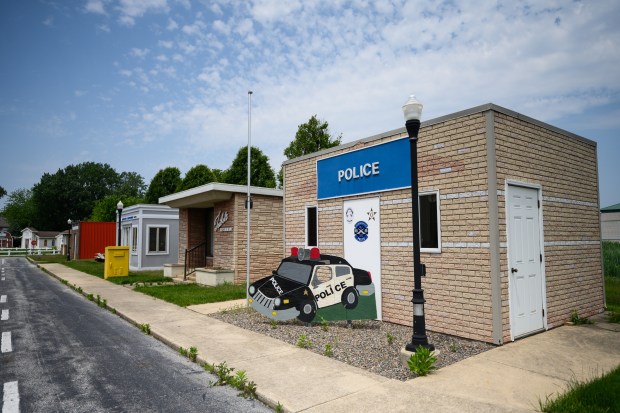To get a handle on the needs of its biggest departments while offering full transparency the Porter County Council held a special needs assessment meeting Wednesday evening.
The Sheriff’s Office and Highway Department each said they need $10 million while Information Technology could use nearly $2 million and still operate at the “poverty level.”
“I thought we would need the big three in front of us,” said County Council Vice President Red Stone, R-1st, who ran the meeting.
He said while nothing was promised he had asked department heads to give an honest appraisal of what’s needed. They didn’t hold back.
Porter County Department of Development & Storm Water Management Director Mike Jabo and Highway Department Superintendent Jim Polarek gave a joint presentation to explain what they do and what they need as they work in close concert.
“There’s never been a consistent level of funding. It’s all over the place,” Jabo said of the roads budget which averages $4.2 million annually. He said the county is falling behind on maintaining its roads and a more holistic approach is needed. “It’s always just paving, paving, paving, but there are other techniques we need to use to take care of our right-of-ways.”
Neglect of the county’s 1,320 miles of ditches, 52,800 feet of culverts, and striping of 787 miles of roadway is an issue, Jabo said. He gave an overview of the science behind road preservation, touched on capital, and presented a chart that shows the county has 12% of its roads in good condition compared to the state average of 27%. Conversely, 37% of the county’s roads are in poor condition while the state average is 27%.
Polarek would like to add a five-person road crew to his department at an annual cost of $760,000. “We talk to a lot of counties and tell them we have 200 (neighborhoods) and they scratch their head because they have 10,” Polarek said of just one aspect of road maintenance his department can’t keep up with.
Jabo, who’s been in the job for 16 months, but has 40 years of experience, said more planning needs to be done, particularly for state funding that requires matching from the county. “I don’t want to go sell a project that we can’t fund,” he said.
Sheriff Jeff Balon was blunt about safety statistics he’s been reluctant to make public in the past. He said the FBI recommends 2.5 patrol officers per 1,000 residents and one jail officer per five inmates. “We were able to raise minimum manpower from five to seven (patrol officers per shift),” he said of increases made since he ordered a manpower assessment in 2023, “but, at the end of the day, it’s not enough.
“You don’t chase crime statistics. You chase population,” he added.
For comparative purposes, he said the Portage Police Department has 75 officers patrolling 25 square miles for 37,000 residents while the Porter County Sheriff’s Office has 70 officers patrolling 430 square miles of unincorporated Porter County for 70,000 residents. And that doesn’t include the SWAT, Bomb Squad, CSI, and drone assistance given by the county to cities and towns.
Balon would like to hire an additional 15 road officers to cut what he calls an “unacceptable” 20-minute non-emergency response time. He would also like to increase salaries by 25% over five years in 5% yearly increments, citing a planned 6% increase for Portage Police next year and the fact that Munster Police 1st Class patrol officers make $10,000 more annually than their Porter County counterparts.
“We don’t ever want Porter County to become a stepping stone to public safety,” Balon said.
He’d also like to build a second storage pole barn for $200,000 and a shooting range for his staff that would cost $750,000. They currently use the Porter County Conservation Club. Balon’s department wish list equates to a $10.3 million budget increase over five years.
Up last was IT Director Lee Childress who said he’d need an additional $390,000 just to complete three mandatory projects this year. The department’s budget nearly doubled from 2023 to ‘24 from $425,000 to $814,000.
As an example of drivers of the budget, Childress explained Windows 10 is expiring soon and the county will be forced to purchase Windows 11 which will require $245,000 worth of new computers. He reminded the council that he had provided four reputable news sources last year that all agreed the average IT budget should be $4 to $5 million per year.
“And you thought I was smoking the wacky weed,” he said. “Three million is considered poverty IT.”
Childress warned the council IT spending may exceed $1.3 million in 2025. “You throw me millions of dollars and there’s no evidence of anything,” he said, comparing software upgrades and the like to tangible goods like squad cars and asphalt purchased by other departments, “but these things have to be done.”
Response from the council was restrained. “I don’t think that now we should be promoting growing county government,” said Councilman Jeremy Rivas, D-2nd. Councilman Greg Simms, D-3rd, didn’t have any remarks but was grim-faced throughout the meeting.
Stone said that while no one hates raising taxes more than him, “If I have to raise LIT (local income tax) I will.”
“I don’t have residents screaming at me to raise taxes and grow government,” Rivas countered.
“I still foresee cuts being on the table,” said Councilman Andy Bozak, R-At-Large. “I would rather tell the departments, ‘Hey, you have to cut 5%.”
“I am a firm believer that we can always be run more efficiently,” said Councilwoman Michelle Harris, R-At-Large. “It all adds up.”
Council President Andy Vasquez, R-4th, and Councilman Mike Brickner, R-At-Large, were not in attendance. Stone has not ruled out further needs assessment meetings, though none are scheduled at this time. Weekly budget workshops like those held last year will begin after Independence Day.
Shelley Jones is a freelance reporter for the Post-Tribune.



